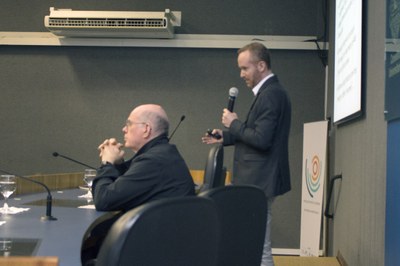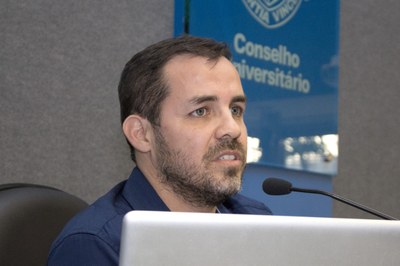On the Size of Time
The first day of conferences of the Intercontinental Academia, Monday, April 20, gave us a counterpoint that might best be described as the contradiction between nearsightedness and farsightedness. Two opposing kinds of personality: one is unable to see clearly what lies in the distance and so approaches each letter as if it were examining ants; the other cannot see what is close at hand, so sees printed matter as if it were looking at stars. The nearsighted enjoys details; the farsighted loves the landscape.
This dichotomy can also be described as the one that exists between a magnifying glass and a spyglass, between a microscope and a telescope, or even between chemistry and physics. Chemists love loupes; physicists, needless to say, having Galileo among them, adore telescopes. Something tells me, as a matter of fact, that physicists must be myopic and chemists hypermetropic, because they are verily surprised when, through a lens, they see what the eyes of the other behold.
 The conferences of physicist Matthew Kleban and chemist René Nome acknowledged this. In fact, to attend both lectures on the same day was a revelatory experience, one being the counterpoint of the other, and not only because of the explicit dichotomy between big and small – i.e., between the galaxy and the molecule – but also because both talks helped me realize that the issue of scale concerns size, certainly, but time as well, or rather, that the size of what one examines implies the size of the time being measured.
The conferences of physicist Matthew Kleban and chemist René Nome acknowledged this. In fact, to attend both lectures on the same day was a revelatory experience, one being the counterpoint of the other, and not only because of the explicit dichotomy between big and small – i.e., between the galaxy and the molecule – but also because both talks helped me realize that the issue of scale concerns size, certainly, but time as well, or rather, that the size of what one examines implies the size of the time being measured.
Kleban, the physicist, who sees things that are afar, spoke of billions of years; Nome, the chemist, who observes things close by, referred to nanoseconds. The zeros went back and forth, either billions of years of age and a billionth fraction of a single second. In a nutshell, what became clear was that time actually measures space, that it is the unit we have to diagnose bodies – a cell cannot be described in years, a star cannot be ascertained in days.
Kleban opened his talk with a fundamental question, “What is the difference between past and future?” He claimed that physicists doubt a discrepancy exists between the two instances. I think Luther, who believed in predestination, would agree with Kleban, but beyond that, what this shows is that time is a matter of space. And if we can go back in one, why shouldn’t we be able do it in the other?
Kleban then discussed his specific field, cosmology, a science dedicated to writing the biographies of galaxies and stars, and which has determined the age of the universe to be 14 billion years. How?! I always wondered how someone could establish such a number, but Kleban answered my eternal question very clearly and very simply: by means of Hubble’s Law. Hubble was the scientist who noticed that galaxies farthest from Earth were moving faster away from it, confirming that the universe is expanding. By calculating how fast they were moving away, he was able to determine when they had all been together. He called this moment “the beginning,” if not of time, at least of the world, the genesis of everything.
Several others things were fascinating in his talk. For example, he described how the Milky Way seemed like a stroke in the sky because of the viewpoint from which we observe it. From our humble world, we see only the side of what is really an ellipse and misname it “Way.” One more thing worthy of note – and I’m already leaving too much out – was the use of the first person in the lecture, something one does not often see in a scientist. Several times during his presentation, Kleban used the pronoun “I” to state his own views and opinion, that is to say, the viewpoint from which he observed history and the heavens, emphasizing his awareness of his position on the globe, even if his subject was everything that’s outside it. Like Kepler, Kleban did not lose his own perspective, as in the following observation he made: “How can we count in years, that is, in number of revolutions around the sun, something that existed before the sun itself was there?”
 René Nome, the chemist, in turn, also talked about extraordinary matters. His lecture focused on how to record motion inside the cells, movements that occur at unthinkable speeds. Nome showed the first picture ever taken of a galloping horse, which shocked the 19th century world because motion had heretofore never been stopped and, thus, no one had ever understood how galloping worked, a matter that implied profound anatomical questions. Everything that was thought about galloping horses went overboard after that picture; one has only to look at Gericault’s painting from a couple of decades earlier.
René Nome, the chemist, in turn, also talked about extraordinary matters. His lecture focused on how to record motion inside the cells, movements that occur at unthinkable speeds. Nome showed the first picture ever taken of a galloping horse, which shocked the 19th century world because motion had heretofore never been stopped and, thus, no one had ever understood how galloping worked, a matter that implied profound anatomical questions. Everything that was thought about galloping horses went overboard after that picture; one has only to look at Gericault’s painting from a couple of decades earlier.
Nome went on to explain how that process had continued, achieving ever greater precision in the capture of minuscule moments, helping us understand the motions of particles inside a cell. To accomplish this, it was necessary to distend time, that is, to create slow motion mechanisms capable of showing us what happens very, very quickly. From galloping horses to photosynthesis, this is the scope of Nome’s studies. His aim is to understand photosynthesis, the process by which plants capture sunlight for energy and that takes place at enormous speed – although I do not know if it is greater than that which separates the stars. Perhaps I should say I don’t if they’re comparable, because one seems slow (given the enormous distances) and the other seems fast (because it is very near).
Finally, one more comment: Nome displayed an absolutely amazing machine, a container with some sort of contraption that made it possible to whirl the liquid held inside. Nome proceeded to put three drops of colored ink, spin the device and mix the colors. He then spun the device in reverse and the colors were separated, becoming three drops of ink again. Contemplating our expressions of infinite distrust, Nome assured us that there was no film running backward; it was a chemical effect, an effect of extraordinary beauty that gave us the feeling, of course, of having turned back the clock, of going back in time.
He showed many more of these curiosities of science, which are its foundation. Every scientist is a spy, every scientist must be deeply suspicious, and that is why their search never ends.
Going back to the beginning, the curious thing about both lectures, about the relationship between them, was the dialogue between the diminutive and the humungous, questions of size that resulted in questions of time: each scientist seemed to use a fraction of time that was diametrically opposed, yet it was essentially one and same time – ours – of which we can only have a notion thanks to our traveling spaceship, our planet Earth. Kleban measures the universe in years, that is, how long Earth takes to travel around the Sun; Nome measures his particles in nanoseconds, which after all are nothing but fragments of a day-hour-minute- second-nanosecond, this is, of the time our beloved Earth takes to spin around itself.
